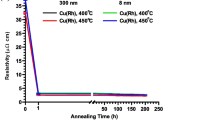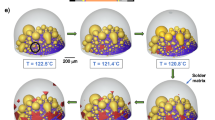Abstract
The formation and growth of intermetallic compound (IMC) layer at the interface between pure Sn and a Cu substrate during dip soldering and aging were studied. The soldering was conducted at 250 °C using dipping method, followed by aging treatment at 150 °C for up to 10 days. The results showed that the IMC layer flattened with aging duration because the grooves in scallop-like IMC provide a more convenient access for Cu atoms to dissolve and react with solders and previous IMCs. And when isothermal aging was subjected, the growth rate of Cu6Sn5 was lower than that of Cu3Sn due to Cu3Sn growing rapidly with aging time by consuming Cu6Sn5 at the interface of Cu3Sn/Cu6Sn5. Kirkendall voids were observed at Cu3Sn/Cu interface as well as inside the Cu3Sn layer as the Sn/Cu couple was aged at 150 °C for prolonged time, with which the Cu3Sn IMC dominates the interfacial IMCs growth. During solid-state aging, the mean diameter (d) of interfacial Cu6Sn5 grains increased dramatically with the increasing time (t). The relationships between d and t were given to be d = 1.22 t 0.291 for samples formed at 250 °C for 1 min and d = 1.53 t 0.259 for samples formed at 250 °C for 5 min, respectively.









Similar content being viewed by others
References
T. Laurila, V. Vuorinen, J.K. Kivilahti, Interfacial reactions between lead-free solders and common base materials. Mater Sci Eng R 49, 1–60 (2005)
T. Laurila, V. Vuorinen, M. Paulasto-Kröckel, Impurity and alloying effects on interfacial reaction layers in Pb-free soldering. Mater Sci Eng R 68, 1–38 (2010)
X. Hu, Y. Li, Z. Min, Interfacial reaction and growth behavior of IMCs layer between Sn–58Bi solders and a Cu substrate. J Mater Sci Mater Electron 24, 2027–2034 (2013)
X. Hu, Y. Li, Z. Min, Interfacial reaction and IMC growth between Bi-containing Sn0.7Cu soldiers and Cu substrate during soldering and aging. J Alloy Compd 582, 341–347 (2014)
C. Lejuste, F. Hodaj, L. Petit, Solid state interaction between a Sn–Ag–Cu–In solder alloy and Cu substrate. Intermetallics 36, 102–108 (2013)
J.O. Suh, K.N. Tu, G.V. Lutsenko, A.M. Gusak, Size distribution and morphology of Cu6Sn5 scallops in wetting reaction between molten solder and copper. Acta Mater 56, 1075–1083 (2008)
H.F. Zou, H.J. Yang, Z.F. Zhang, Coarsening mechanisms, texture evolution and size distribution of Cu6Sn5 between Cu and Sn-based soldiers. Mater Chem Phys 131, 190–198 (2011)
Z. Zhang, M. Li, C. Wang, Fabrication of Cu6Sn5 single-crystal layer for under-bump metallization in flip-chip packaging. Intermetallics 42, 52–55 (2013)
J. Shen, M. Zhao, P. He, Y. Pu, Growth behaviors of intermetallic compounds at Sn-3Ag-0.5Cu/Cu interface during isothermal and non-isothermal aging. J Alloy Compd 574, 451–458 (2013)
M. Yang, M. Li, C. Wang, Interfacial reactions of eutectic Sn3.5Ag and pure tin solders with Cu substrates during liquid-state soldering. Intermetallics 25, 86–94 (2012)
M. Yang, Y. Cao, S. Joo, H. Chen, X. Ma, M. Li, Cu6Sn5 precipitation during Sn-based solder/Cu joint solidification and its effects on the growth of intermetallic compounds. J Alloy Compd 582, 688–695 (2014)
A.M. Gusak, K.N. Tu, Kinetic theory of flux-driven ripening. Phys Rev B 66, 115403–115416 (2002)
C.B. Carter, M.G. Norton, Ceramic materials, science and engineering (Springer, New York, 2007)
G. Ghosh, Dissolution and interfacial reactions of thin-film Ti/Ni/Ag metallizations in solder joints. Acta Mater 49, 2609–2624 (2001)
C.-Y. Yu, W.-Y. Chen, J.-G. Duh, Suppressing the growth of Cu–Sn intermetallic compounds in Ni/Sn-Ag-Cu/Cu-Zn solder joints during thermal aging. Intermetallics 26, 11–17 (2012)
Q.S. Zhu, Z.F. Zhang, J.K. Shang, Z.G. Wang, Fatigue damage mechanisms of copper single crystal/Sn–Ag–Cu interfaces. Mater Sci Eng A 435–436, 588–594 (2006)
W. Yang, R.W. Messier, L.E. Felton, Microstructure evolution of eutectic Sn–Ag solder joints. J Electron Mater 23, 765–772 (1994)
M. Yang, M. Li, J. Kim, Texture evolution and its effects on growth of intermetallic compounds formed at eutectic Sn37Pb/Cu interface during solid-state aging. Intermetallics 31, 177–185 (2012)
Acknowledgments
This work was supported by the Nature Science Foundation of Jiangxi province (20122BAB216023), the Open Foundation of Key Laboratory of Jiangxi Copper Tungsten New Materials (2012-KLP-4).
Author information
Authors and Affiliations
Corresponding author
Rights and permissions
About this article
Cite this article
Hu, X., Ke, Z. Growth behavior of interfacial Cu–Sn intermetallic compounds of Sn/Cu reaction couples during dip soldering and aging. J Mater Sci: Mater Electron 25, 936–945 (2014). https://doi.org/10.1007/s10854-013-1667-3
Received:
Accepted:
Published:
Issue Date:
DOI: https://doi.org/10.1007/s10854-013-1667-3




